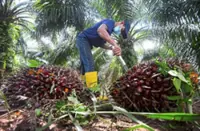A rice farmer checking his paddy field which has been hit by the extreme hot weather in Mindanao. — Filepic/Philippine Daily Inquirer/ANN
THE Special Geographic Area in the Philippines is a patchwork of 63 barangays in six municipalities of Cotabato province that joined the Bangsamoro Autonomous Region in Muslim Mindanao in a plebiscite in 2019.
As with the entire region, it represents hope for lasting peace after decades of armed conflict. However, the transition to peace has been fraught with long- standing and emergent challenges.
Various armed groups – former rebels, violent extremists, communist insurgents, and various paramilitary groups – continue to hold sway. Violence is also complicated by longstanding land disputes, dating back decades. However, a new threat has surfaced: El Niño’s searing grip.
Farmers report widespread crop failures that highlight the severity of the drought compared with previous experiences. The dry spell’s reach extends beyond the padi fields to households, impacting food security and health in the Philippines.
Observers still see the threat posed by the drought as natural, but the subsequent upheavals are increasingly manmade.
For example, communities in Pikit rely on rainfed farming for rice, corn, and other cash crops. Disputes have erupted when water recedes in the Liguasan Marsh during the dry season, exposing land for farming.
The rainy season will soon return and re-cover the exposed ground. This small window of opportunity sparks a scramble to plant a stake in the ground, and families living near the marsh, some of whom are linked with armed groups, have a history of violent clashes over these exposed plots.
At the same time, mounting tensions and armed intimidation due to rival claims to water for irrigation are rising in communities that were previously part of the municipality of Midsayap, North Cotabato.
Those at the tail end of an irrigation system breached a portion of the canal embankment of already irrigated farm plots and rerouted water into their fields. With no legal relief for their suffering, aggrieved farmers are now contemplating violent retaliatory actions.
The Council for Climate and Conflict Action Asia established a conflict alert and critical events monitoring system that monitors and analyses conflict data in Bangsamoro. Our partner, the Early Response Network, responds to and mitigates conflicts based on a nuanced understanding of violence in the region.
Meanwhile, rural women deplore the drought’s disproportionate impact on them.
Their already limited household income is further strained by the added cost of purchasing potable water, caring for sick children and the elderly, and even longer journeys by foot to locate and fetch water – all of which need more time spent managing increasingly scarce resources.
Water from deep wells that are often managed by women and is a traditional source for household consumption has dried up at an alarming rate. Hence, many wells have been ring-fenced to prevent access by neighbouring communities.
Fragility of reciprocity
The absence of smoke emanating from a neighbour’s kitchen serves as a powerful sign of extreme hardship. It indicates that hunger has set in, invoking the well-established Islamic principle of mutual aid in times of crisis.
Neighbours, even those with limited means, offer what they can – a cup of rice, a jar of sugar, or a share of whatever harvest they have – a strong testament to the enduring spirit of solidarity that still holds in the Bangsa-moro people. But how long will this goodwill hold?
The longer the drought lasts, the higher the likelihood of violent flashpoints. Hunger and desperation can quickly morph into violence, especially in areas where armed groups are already present.
The drought has become a potent accelerant, exacerbating existing tensions and pushing communities to the brink. Closeknit groups of clans and families provide support in times of distress, serving as the communities’ first and last line of defence.
What happens when they can no longer guarantee water and food security? Will altruism survive the lack of smoke from a neighbour’s kitchen?
The future hangs in the balance.
Can the government, the Bangsamoro Autonomous Region, and other groups intervene effectively to mitigate El Niño’s impact?
Can existing peace mechanisms be strengthened to prevent conflict over dwindling resources?
Most importantly, can solutions be found to address not only the current crises but also the underlying causes of land disputes and social inequality?
El Niño is a reminder of the interconnectedness of environmental, social, and political issues. By addressing the immediate needs of communities, investing in long-term solutions, and strengthening the foundations of peace, we can transform El Niño’s threat into a catalyst for positive change. – Philippine Daily Inquirer/Asia News Network
Maureen Lacuesta is a programme manager of the Council for Climate and Conflict Action Asia, an independent peacebuilding organisation whose work is rooted in partnerships and evidence in the Philippines.





